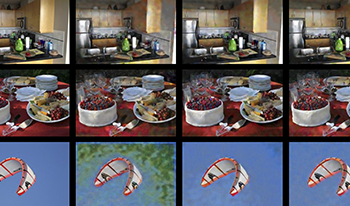References
1AkbariniaA.ParragaC. A.2017Colour constancy beyond the classical receptive fieldIEEE Trans. Pattern Anal. Mach. Intell.40208120942081–9410.1109/TPAMI.2017.2753239
2AkbariniaA.ParragaC. A.2018Feedback and surround modulated boundary detectionInt. J. Comput. Vis.126136713801367–8010.1007/s11263-017-1035-5
3AkbariniaA.Gil RodríguezR.2020Deciphering image contrast in object classification deep networksVis. Res.173617661–7610.1016/j.visres.2020.04.015
4BarlowH. B.Possible principles underlying the transformation of sensory messagesSensory Communication1961MIT PressCambridge, UK217234217–34
5BuchsbaumG.AllanG.1983Trichromacy, opponent colours coding and optimum colour information transmission in the retinaProc. R. Soc. Lond. B2208911389–11310.1098/rspb.1983.0090
6BurnsM. E.LambT. D.16. visual transduction by rod and cone photoreceptorsVisual Neuroscience2003MIT Press215233215–33
7CernadasE.Fernández-DelgadoM.González-RufinoE.CarriónP.2017Influence of normalization and color space to color texture classificationPattern Recognit.61120138120–3810.1016/j.patcog.2016.07.002
8ChirimuutaM.KingdomF. A. A.2015The uses of colour vision: Ornamental, practical, and theoreticalMinds Mach.25213229213–2910.1007/s11023-015-9364-z
9ClausenC.WechslerH.2000Color image compression using pca and backpropagation learningPattern Recognit.33155515601555–6010.1016/S0031-3203(99)00126-0
10
11CookR. D.1977Detection of influential observation in linear regressionTechnometrics19151815–8
12DerringtonA. M.KrauskopfJ.LennieP.1984Chromatic mechanisms in lateral geniculate nucleus of macaqueThe J. Physiol.357241265241–6510.1113/jphysiol.1984.sp015499
13DengJ.DongW.SocherR.LiL.-J.LiK.Fei-FeiL.Imagenet: A large-scale hierarchical image databaseProc. IEEE Int’l. Conf. on Computer Vision and Pattern Recognition2009IEEEPiscataway, NJ248255248–55
14EngilbergeM.CollinsE.SüsstrunkS.Color representation in deep neural networksProc. IEEE Int’l. Conf. on Image Processing2017IEEEPiscataway, NJ278627902786–90
15FosterD. H.Marín-FranchI.NascimentoS.AmanoK.Coding efficiency of cie color spacesProc. IS&T/SID CIC16: Sixteenth Color Imaging Conference2008IS&TSpringfield, VA285288285–8
16FuH.WangB.ShenJ.CuiS.XuY.LiuJ.ShaoL.Evaluation of retinal image quality assessment networks in different color-spacesInt’l. Conf. on Medical Image Computing and Computer-Assisted Intervention2019485648–56
17GegenfurtnerK. R.SharpeL. A.Color Vision1999Cambridge University PressCambridge, UK
18GeversT.SmeuldersA. W.1999Color-based object recognitionPattern Recognit.32453464453–6410.1016/S0031-3203(98)00036-3
19Gil RodríguezR.Vazquez-CorralJ.BertalmíoM.2020Color matching images with unknown non-linear encodingsIEEE Trans. Image Process.29443544444435–4410.1109/TIP.2020.2968766
20HeK.ZhangX.RenS.SunJ.Deep residual learning for image recognitionProc. IEEE Int’l. Conf. on Computer Vision and Pattern Recognition2016IEEEPiscataway, NJ770778770–8
21KakumanuP.MakrogiannisS.BourbakisN.2007A survey of skin-color modeling and detection methodsPattern Recognit.40110611221106–2210.1016/j.patcog.2006.06.010
22KalatJ. W.Biological psychologyNelson Education2015Cengage Learning, MA
23KimH.-K.ParkJ. H.JungH.-Y.2018An efficient color space for deep-learning based traffic light recognitionJ. Adv. Transportation201810.1155/2018/2365414
24KingmaD. P.WellingM.2019An introduction to variational autoencodersFoundations and Trends in Machine Learning12307392307–9210.1561/2200000056
25KirillovA.HeK.GirshickR.RotherC.DollárP.Panoptic segmentationProc. IEEE Conf. on Computer Vision and Pattern Recognition2019IEEEPiscataway, NJ940494139404–13
26KoenderinkJ.DoornA. v.GegenfurtnerK.
27KoenderinkJ.van DoornA. J.Perspectives on Colour Space2003Oxford UniversityNew York
28LaparraV.JiménezS.Camps-VallsG.MaloJ.2012Nonlinearities and adaptation of color vision from sequential principal curves analysisNeural Computation24275127882751–8810.1162/NECO˙a˙00342
29LarbiK.OuardaW.DriraH.AmorB. B.AmarC. B.Deepcolorfasd: Face anti spoofing solution using a multi channeled color spaces cnnProc. IEEE Int’l. Conf. on Systems, Man, and Cybernetics2018IEEEPiscataway, NJ401140164011–6
30LarssonG.MaireM.ShakhnarovichG.Colorization as a proxy task for visual understandingProc. IEEE Int’l. Conf. on Computer Vision and Pattern Recognition2017IEEEPiscataway, NJ687468836874–83
31LaughlinS.1981A simple coding procedure enhances a neuron’s information capacityZ. Natforsch. c36910912910–210.1515/znc-1981-9-1040
32LinT.-Y.MaireM.BelongieS.HaysJ.PeronaP.RamananD.DollárP.ZitnickC. L.Microsoft coco: Common objects in contextProc. European Conf. on Computer Vision2014SpringerCham740755740–55
33LiuZ.LuoP.WangX.TangX.Deep learning face attributes in the wildProc. IEEE Int’l. Conf. on Computer Vision and Pattern Recognition2015IEEEPiscataway, NJ373037383730–8
34McCullochW. S.PittsW.1943A logical calculus of the ideas immanent in nervous activityThe Bulletin of Mathematical Biophysics5115133115–3310.1007/BF02478259
35MechrezR.ShechtmanE.Zelnik-ManorL.Photorealistic style transfer with screened poisson equationProc. The British Machine Vision Conf.2017BMVA PressUK153.1153.12153.1–153.12
36MishkinD.SergievskiyN.MatasJ.2017Systematic evaluation of convolution neural network advances on the imagenetComput. Vis. Image Underst.161111911–910.1016/j.cviu.2017.05.007
37MoroneyN.FairchildM. D.1995Color space selection for jpeg image compressionJ. Electronic Imaging4373382373–8210.1117/12.217266
38MoslehA.SharmaA.OnzonE.MannanF.RobidouxN.HeideF.Hardware-in-the-loop end-to-end optimization of camera image processing pipelinesProc. IEEE Conf. on Computer Vision and Pattern Recognition2020IEEEPiscataway, NJ752975387529–38
39Muñoz-SalinasR.2008A Bayesian plan-view map-based approach for multiple-person detection and trackingPattern Recognit.41366536763665–7610.1016/j.patcog.2008.06.013
40ParragaC. A.AkbariniaA.2016Nice: A computational solution to close the gap from colour perception to colour categorizationPloS one11e014953810.1371/journal.pone.0149538
41PrattW.Digital Image Processing20074th ed.John Wiley & SonsHoboken, NJ
42QiuG.2002Indexing chromatic and achromatic patterns for content-based colour image retrievalPattern Recognit.35167516861675–8610.1016/S0031-3203(01)00162-5
43ReinhardE.AdhikhminM.GoochB.ShirleyP.2001Color transfer between imagesIEEE Comput. Graph. Appl.21344134–4110.1109/38.946629
44RabbaniM.2002Jpeg2000: Image compression fundamentals, standards and practiceJ. Electronic Imaging1128610.1117/1.1469618
45RafegasI.VanrellM.2018Color encoding in biologically-inspired convolutional neural networksVis. Res.1517177–1710.1016/j.visres.2018.03.010
46SalimansT.GoodfellowI.ZarembaW.CheungV.RadfordA.ChenX.Improved techniques for training gansAdvances in Neural Information Processing Systems2016Curran Associates Inc.NY223422422234–42
47SharmaG.WuW.DalalE. N.2005The CIEDE2000 color-difference formula: Implementation notes, supplementary test data, and mathematical observationsColor Res. Appl.30213021–3010.1002/col.20070
48StarosolskiR.2014New simple and efficient color space transformations for lossless image compressionJ. Vis. Commun. Image Represent.25105610631056–6310.1016/j.jvcir.2014.03.003
49StokmanH.GeversT.2007Selection and fusion of color models for image feature detectionIEEE Trans. on Pattern Anal. Machine Intell.29371381371–8110.1109/TPAMI.2007.58
50TishbyN.ZaslavskyN.Deep learning and the information bottleneck principleIEEE Information Theory Workshop2015IEEEPiscataway, NJ151–5
51TheisL.ShiW.CunninghamA.HuszárF.Lossy image compression with compressive autoencodersInt’l. Conf. on Learning2017ICLR, CA
52van den OordA.VinyalsO.KavukcuogluK.Neural discrete representation learningAdvances in Neural Information Processing Systems2017Curran Associates Inc.NY630663156306–15
53WangZ.BovikA. C.SheikhH. R.SimoncelliE. P.2004Image quality assessment: from error visibility to structural similarityIEEE Trans. Image Process.13600612600–1210.1109/TIP.2003.819861
54WuergerS.XiaoK.Color Vision, Opponent Theory2016SpringerBerlin413418413–8
55WyszeckiG.StilesW. S.Color Science1982Vol. 8WileyNew York
56YuG.VladimirovaT.SweetingM. N.2009Image compression systems on board satellitesActa Astronaut.649881005988–100510.1016/j.actaastro.2008.12.006
57ZhangR.IsolaP.EfrosA. A.Split-brain autoencoders: Unsupervised learning by cross-channel predictionProc. IEEE Conf. on Computer Vision and Pattern Recognition2017IEEEPiscataway, NJ105810671058–67

 Find this author on Google Scholar
Find this author on Google Scholar Find this author on PubMed
Find this author on PubMed